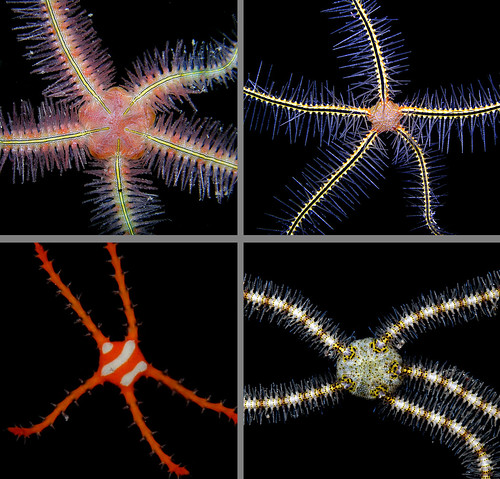I've done similar profiles for the researchers in Paris at the Museum natioinal d'Histoire naturelle (here)! I think this gives everyone a bit of insight into the many different crew members which staff the various roles in the big research seen in scientific papers. And Dr. Tim O'Hara's lab has had a good week for "big research paper drops" with more to come!!
Just as a refresher though.. Here's a pic with the BIG project that Tim O'Hara's lab has been working on for the last several years: the BIG ophiuroid (aka the brittle and basket star) phylogeny! aka the "family tree" of the ophiuroids!
As I've mentioned previously, the new phylogeny is a BIG deal. It involves a group with over 2000 species which has been a taxonomic headache to scientists for over 100 years. Their research has literally turned this whole field on its head! (if brittle stars had a head!)
The tree clarifies which groups show support for being "real" and elaborates on how different brittle star and basket groups are related to one another. It will almost DOUBLE the number families!!!
The tree itself is HUGE. Here it is below printed out and mounted on the wall for easy reference. You can see that it extends from that lower bookshelf to the that top shelf-so the printout is easily 6 feet tall (or two meters)!!
The tree was made using a phylogenomic data set. This is different from a lot of the molecular trees made in the last 20 years because it includes a whopping 425 genes and over 60 taxa! (other trees generally use only 3 to 10) You can see the big paper as published in Current Biology here.
The Echinoderm researchers at Museum Victoria includes a diversity of workers!
1. Dr. Andrew Hugall
Where Tim O'Hara provides the "Ophiuroid Taxonomy and context", Dr. Hugall is the phylogenetics and analytical guru part of the "Big Ophiuroid" team. Although he is currently working on marine invertebrates, he worked previously on birds, discovering "Accelerated speciation" in highly colorful birds, a paper which was published in Nature in 2012. You can see that here.
Dr. Hugall worked on the analytical aspects of the project and, in conjunction with Dr. O'Hara, cleaned up the genetic data in order to make it ready for analysis. He also provides a good complement to the "natural history" side of the lab with a powerful analytical background.
2. Lupita Bribiesca
Lupita is a PhD student at the University of Melbourne and got her undergraduate degree from the Universidad Nacional Autónoma de México. She's not only very proficient in computer coding and analysis but she's already a prolific author in echinoderm systematics! Especially in anchialine cave echinoderms!
In Mexico, Lupita worked on echinoderms which lived in submarine caves fed by the ocean. Some of her work can be found
and some recent work with Dr. Mark O'Loughlin on asterinid sea stars in the genus Aquilonastra! (here)
3. Skipton "Skip" Woolley
Skip is a relatively new name on the echinoderm scene! But started out in grand fashion! His name of course headlines last week's BIG NATURE paper on ophiuroid deep-sea diversity! (here)
He's been doing analytical work looking at "big picture" diversity patterns in ophiuroids. His prior paper looked at biogeographical subdivisions in Western Australia in the journal Diverstiy & Distributions.
I featured Kate Naughton's work on the blog back in 2009 when she and Tim O'Hara discovered a brooding "cryptic" species of the Australian Biscuit Star Tosia using molecular tools to understand the relationships of Tosia australis along the Australian coast. (see this story here)
Since then Kate has received her PhD and continued to do her awesome work combining ecology, taxonomy and molecular phylogenetics at Museum Victoria.
These days she's been working a LOT on feather star (i.e., crinoid) taxonomy and diversity in Australia. It turns out that there's a LOT of these in Australia that remain to be discovered and what's known requires a lot of work.
As with many of us, she seeks a good job, funding for her research and all of life's finer things!
She HAS however also been working on new species of brittle stars in the genus Ophionereis!
 |
| photo by John Keesing |

5. P. Mark O'Loughlin and Deep Sea Sea Cucumbers
One of the most established echinoderm researchers at Museum Victoria was actually Tim O'Hara's original mentor!
Mark O'Loughlin has been a fixture of the "marine invertebrates" scene in the Melbourne/Victoria area of Australia for decades. He's published a huge volume of work on echinoderms, including sea stars and sea cucumbers. Here's his profile at ResearchGate!
here's a sclerite from a new species of "sea pig" (Family Elpidiidae) that Mark is currently working on from the the Great Australian Bight (979 m)
Mark has been working steadfastly into his 80s but has assisted by many student workers (one of which is seen here)
My thanks to the Museum Victoria for my visit! About 1000 specimen lots identified!
Until NEXT TIME, Melbourne!!















No comments:
Post a Comment